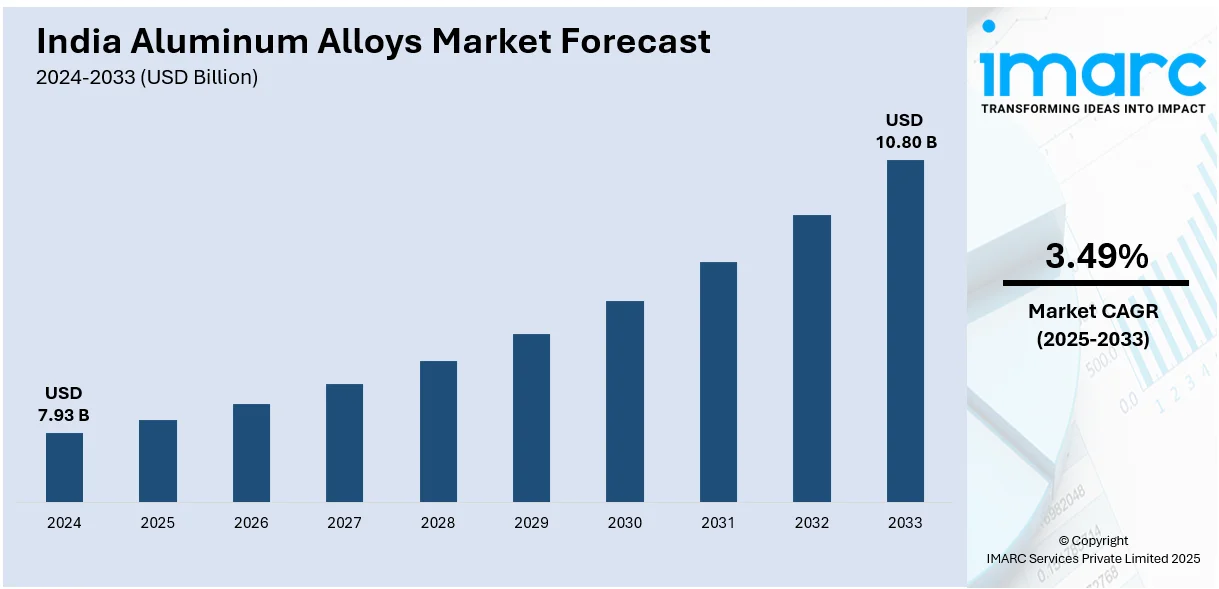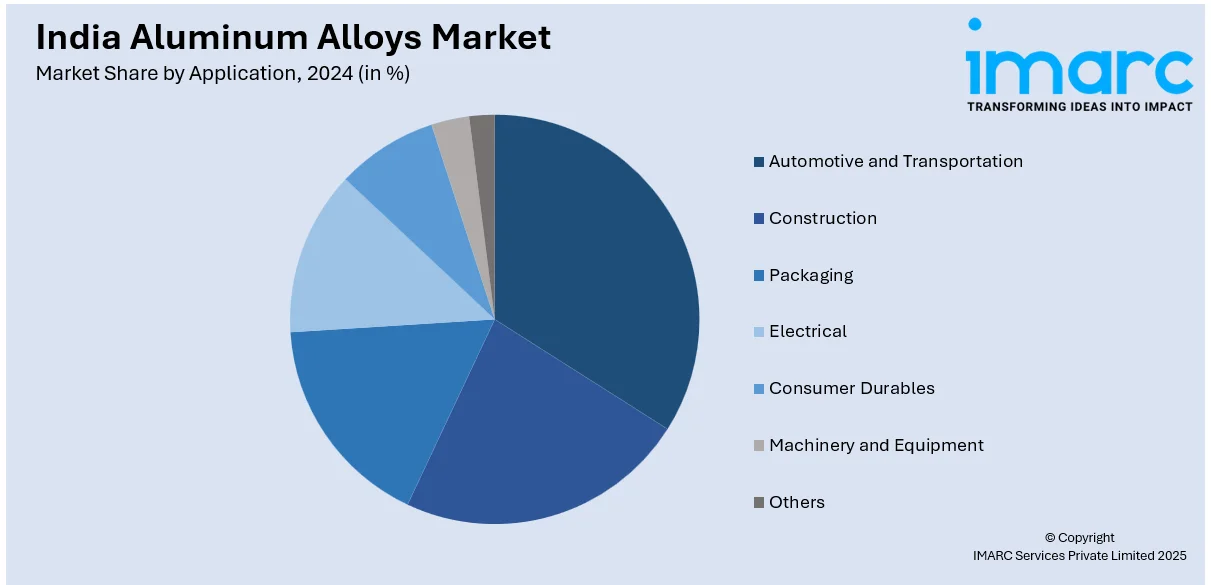
India Aluminum Alloys Market Size, Share, Trends and Forecast by Application, and Region, 2025-2033
India Aluminum Alloys Market Overview:
The India aluminum alloys market size reached USD 7.93 Billion in 2024. Looking forward, IMARC Group expects the market to reach USD 10.80 Billion by 2033, exhibiting a growth rate (CAGR) of 3.49% during 2025-2033. The market is driven by the automotive industry's shift toward lightweight, fuel-efficient materials and the government's push for electric vehicles. Additionally, rapid infrastructure development, including smart cities and transportation projects, augments India aluminum alloys market share. Aluminum alloys' durability, recyclability, and corrosion resistance further support their growing adoption across industries.
|
Report Attribute
|
Key Statistics
|
|---|---|
|
Base Year
|
2024 |
|
Forecast Years
|
2025-2033
|
|
Historical Years
|
2019-2024
|
| Market Size in 2024 | USD 7.93 Billion |
| Market Forecast in 2033 | USD 10.80 Billion |
| Market Growth Rate 2025-2033 | 3.49% |
India Aluminum Alloys Market Trends:
Growing Demand for Aluminum Alloys in Automotive Industry
The India aluminum alloys market outlook is positively being affected, driven by the expanding automotive sector. According to forecasts, 85 million EVs will be on the road globally by 2025, out of which India will have 500,000 EVs, including 370,000 battery electric vehicles (BEVs) and 129,500 plug-in hybrid electric vehicles (PHEVs). Much of this growth has been driven by government-backed programs including, the Faster Adoption and Manufacturing of (Hybrid &) Electric Vehicles (FAME). With the EV adoption rate increasing up to 51% in the Indian market, the automotive manufacturing sector is likely to have a demand for lightweight aluminum alloys. Moreover, the aluminum alloy market in India is likely to see significant growth, with forecasts showing 95% of materials from battery recycling by 2030. With increasing emphasis on fuel efficiency and emission reduction, automakers are increasingly adopting lightweight materials such as aluminum alloys to replace traditional steel components. Aluminum alloys offer a perfect balance of strength and weight reduction, making them ideal for manufacturing engine parts, wheels, and body panels. The Indian government’s push for electric vehicles (EVs) further amplifies this trend, as EVs require lightweight materials to enhance battery efficiency and extend driving range. Additionally, rising consumer preference for high-performance and eco-friendly vehicles is fueling the demand for aluminum alloys. This trend is expected to continue as automotive manufacturers align with global sustainability goals, making aluminum alloys a critical material in the industry’s future.

To get more information on this market, Request Sample
Infrastructure Development Enhanced Aluminum Alloy Consumption
The India aluminum alloys market growth can be accredited to the country’s rapid infrastructure development. Government initiatives such as the Smart Cities Mission, affordable housing projects, and investments in transportation infrastructure are driving the demand for aluminum alloys in construction and urban development. The deadline for India’s Smart Cities Mission has been extended to March 2025 to allow for the completion of 830 pending projects worth ₹19,926 crore (approximately USD 2.43 Billion), while 90% of projects have already been completed. Urban infrastructure development continues to be a priority, with ₹46,585 Crore (approximately USD 5.68 Billion) (97% of allocated funds) released and 93% utilized. With construction gaining pace in India, the demand for aluminum alloys used in smart city initiatives, including eco-friendly buildings and transport, is rising. Aluminum alloys are widely used in building facades, roofing, and window frames due to their durability, corrosion resistance, and aesthetic appeal. Moreover, the expansion of metro rail networks and airports across the country is creating a rise in demand for aluminum alloys in structural applications. The material’s recyclability aligns with the growing focus on sustainable construction practices, further enhancing its adoption. As India continues to invest in modernizing its infrastructure, the aluminum alloys market is poised for sustained growth in the coming years.
India Aluminum Alloys Market Segmentation:
IMARC Group provides an analysis of the key trends in each segment of the market, along with forecasts at the country level for 2025-2033. Our report has categorized the market based on application.
Application Insights:

- Automotive and Transportation
- Construction
- Packaging
- Electrical
- Consumer Durables
- Machinery and Equipment
- Others
The report has provided a detailed breakup and analysis of the market based on the application. This includes automotive and transportation, construction, packaging, electrical, consumer durables, machinery and equipment, and others.
Regional Insights:
- North India
- South India
- East India
- West India
The report has also provided a comprehensive analysis of all the major regional markets, which include North India, South India, East India, and West India.
Competitive Landscape:
The market research report has also provided a comprehensive analysis of the competitive landscape. Competitive analysis such as market structure, key player positioning, top winning strategies, competitive dashboard, and company evaluation quadrant has been covered in the report. Also, detailed profiles of all major companies have been provided.
India Aluminum Alloys Market News:
- March 28, 2024: NALCO, as per the Revamped Distribution Sector Scheme (RDSS) of India, launched AL-59 Aluminium Alloy Ingot, developed particularly for the conductors in power transmission and distribution. Renowned for its corrosion resistance, this alloy is especially ideal for coastal areas and ultra-high voltage applications. This will enhance the aluminum alloy market in India, providing a reliable raw material to manufacturers for the production of development conductors.
India Aluminum Alloys Market Report Coverage:
| Report Features | Details |
|---|---|
| Base Year of the Analysis | 2024 |
| Historical Period | 2019-2024 |
| Forecast Period | 2025-2033 |
| Units | Billion USD |
| Scope of the Report |
Exploration of Historical Trends and Market Outlook, Industry Catalysts and Challenges, Segment-Wise Historical and Future Market Assessment:
|
| Applications Covered | Automotive and Transportation, Construction, Packaging, Electrical, Consumer Durables, Machinery and Equipment, Others |
| Regions Covered | North India, South India, East India, West India |
| Customization Scope | 10% Free Customization |
| Post-Sale Analyst Support | 10-12 Weeks |
| Delivery Format | PDF and Excel through Email (We can also provide the editable version of the report in PPT/Word format on special request) |
Key Questions Answered in This Report:
- How has the India aluminum alloys market performed so far and how will it perform in the coming years?
- What is the breakup of the India aluminum alloys market on the basis of application?
- What is the breakup of the India aluminum alloys market on the basis of region?
- What are the various stages in the value chain of the India aluminum alloys market?
- What are the key driving factors and challenges in the India aluminum alloys market?
- What is the structure of the India aluminum alloys market and who are the key players?
- What is the degree of competition in the India aluminum alloys market?
Key Benefits for Stakeholders:
- IMARC’s industry report offers a comprehensive quantitative analysis of various market segments, historical and current market trends, market forecasts, and dynamics of the India aluminum alloys market from 2019-2033.
- The research report provides the latest information on the market drivers, challenges, and opportunities in the India aluminum alloys market.
- Porter's five forces analysis assist stakeholders in assessing the impact of new entrants, competitive rivalry, supplier power, buyer power, and the threat of substitution. It helps stakeholders to analyze the level of competition within the India aluminum alloys industry and its attractiveness.
- Competitive landscape allows stakeholders to understand their competitive environment and provides an insight into the current positions of key players in the market.
Need more help?
- Speak to our experienced analysts for insights on the current market scenarios.
- Include additional segments and countries to customize the report as per your requirement.
- Gain an unparalleled competitive advantage in your domain by understanding how to utilize the report and positively impacting your operations and revenue.
- For further assistance, please connect with our analysts.
 Request Customization
Request Customization
 Speak to an Analyst
Speak to an Analyst
 Request Brochure
Request Brochure
 Inquire Before Buying
Inquire Before Buying




.webp)




.webp)












